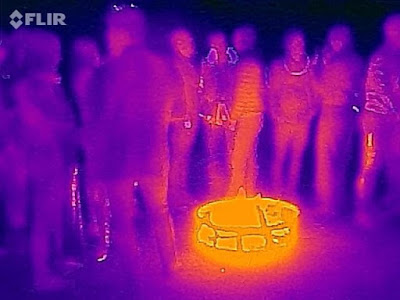 |
| Photo Credit: Public Domain |
By Andrew Bennett
What Is Heat Mean in Physics?
Heat is a bit of a tricky term to work with in science. In everyday use, we typically use heat as a verb to mean "make warmer." We also use it as a noun in reference to the furnace, as in, "turn up the heat."
In science, heat refers specifically to the processes in which thermal energy (kinetic energy for individual atoms) moves from place to place. All objects are doing this all the time, but we find that heat transfers from warmer objects happen faster than from cooler objects, meaning that there is a net flow of energy from warmer to colder objects or locations. As a result, putting a hot cup of tea in your cold hands will always result in the tea getting colder and your hands getting warmer.
Heating Methods
There are three methods of heating: conduction, convection, and radiation. Frequently, we find situations involving heating where all three of these are going on, but one might be happening more than the others. The fact that heating is happening by conduction doesn't mean that convection and radiation aren't also happening.
What Is Conduction?
Conduction involves the transfer of energy, atom to atom, through collisions. Imagine the atoms that make up a frying pan. One of those fancy cast-iron pans – so nice! All the atoms are bound (connected) to the atoms nearby. If we place the pan over a lit burner, the atoms over the burner start getting energy. As a result, those atoms begin to shake more than they were before. Since they are connected to the atoms nearby, that shaking causes other atoms to shake, as well. Since these new atoms are shaking more than they were, we can also say that they are warmer than they were.
 |
| Credit: Public Domain |
Conduction in a Liquid
Conduction in a liquid happens in a similar fashion. Since the atoms in a liquid are more loosely bound to each other, conduction happens more slowly in liquids than in solids (on average).
Conduction in a Gas
Conduction in a gas involves collisions between atoms as they are bouncing around in their containers. The faster an atom is bouncing around, the more energy it has (and the warmer that part of the gas feels). When a fast gas atom collides with a slow one, the typical outcome is that the fast atom slows and the slow atom speeds up. (So, the warm part cools and the cold part warms.) Since the atoms are not connected by any significant force, and they only interact during collisions, heat conduction through gases is typically very slow.
What Is Convection?
The second method of heat transfer, convection, involves moving the energy by moving the matter itself. Many homes are heated by so-called "forced convection" systems. In these systems, the air is heated in just a single location in the house (typically a gas-burning furnace), then a fan is used to push the warm air to the rest of the house. The warm air carries that energy with it.
 |
| Photo Credit: Public Domain |
Does Heat Really Rise?
You've likely heard at some point that "heat rises." This is an oversimplification but does tend to be true. The mechanism here deals with both thermal expansion and buoyancy. If we imagine heating air near the ground, we would find that the air expands as it gets warmer. As a result of this expansion, the air also becomes less dense than it was and than the air around it. As a rule, substances that are less dense will float in substances that are denser, so the warm air begins to float upward, carrying the energy upward with it.
So, to summarize the first two:
So, to summarize the first two:
- Conduction is when energy moves from atom to atom.
- Convection is when atoms carry energy from one place to another.
What Is Radiation?
The last method of heating is through radiation. While this sounds scary, radiation is much broader than the scary stuff coming from nuclear bombs and such. Radiation is broadly defined as energy or particles that are emitted outward from a source. Here, we are referring specifically to electromagnetic (EM) radiation.
 |
| Photo Credit: Flickr/Steve Jurvetson |
What Is EM Radiation?
We break up the different energy levels of EM radiation into the following categories: radio waves, microwaves, infrared, visible light (which is further broken up into the colors of the rainbow), ultraviolet, x-rays, and gamma rays.
If we consider all parts of the electromagnetic spectrum to be light, then every object in the universe is a light source. As electrons jump from higher energy levels to lower ones, they emit light. The visible part of the spectrum is fairly high energy, so only very warm or electrified objects emit light that we can see.
What Is Infrared Radiation?
You've likely seen something like "thermal goggles," which detect infrared radiation and display it as visible light. In this technology, objects near room temperature can be seen to be acting as light sources. You might also have heard that mosquitoes (among other creatures) can see some infrared light, meaning that you and I look like big glowing buffets to them.After this light is emitted, it can hit another object (nearby or over extremely large distances) and be absorbed. In this process, the energy is transferred from one object to another and is carried by electromagnetic waves.
Video: Types of Heating
In the video below, I discuss all three types of heating and give several examples of each.
If viewing via email, click here to watch the video.
Want More Thermodynamics Videos?
Check out this playlist on my YouTube channel for more information about thermodynamics, including thermal expansion and the efficiency of heat engines.
If you would like to receive an email when I publish another post to this blog, please subscribe.
Comments
Post a Comment